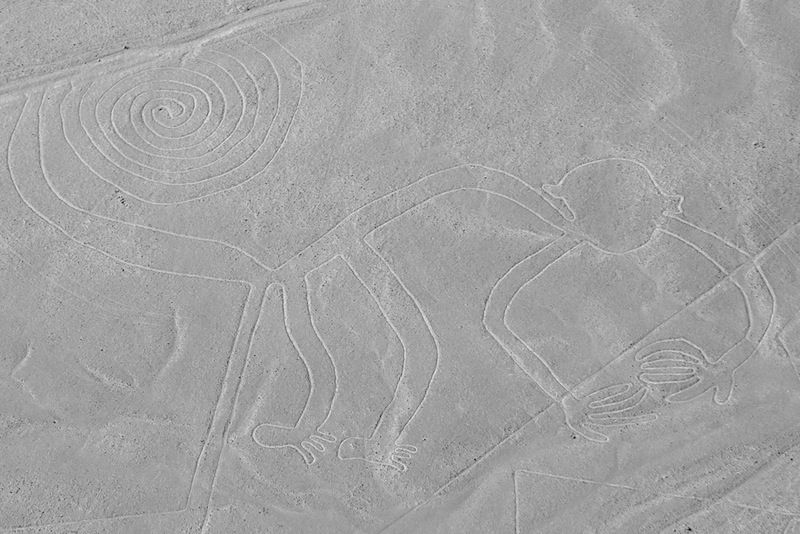The Biggest Solved and Unsolved Mysteries of 2016

Hobbits were established to NOT be human, we learned what killed off an ancient, giant ape, but we still don't know what caused the "Wow!" signal nor what happened to Malaysian Flight 370.
Solved: Nazca Rings
The Nazca region of Peru is famous for its series of massive geoglyphs etched into the landscapes. The images formed familiar animals and shapes, such as the monkey in this photo. Research published last year found that they may have been used as a pilgrimage route to an ancient temple.
In 2016, using high-resolution satellite images, archaeologists determined that the series of lines, known as puquios, served as a hydraulic system to retrieve water from underground aquifers.
"What is clearly evident today is that the puquio system must have been much more developed than it appears today," Rosa Lasaponarac from the Institute of Methodologies for Environmental Analysis in Italy told BBC News. "Exploiting an inexhaustible water supply throughout the year the puquio system contributed to an intensive agriculture of the valleys in one of the most arid places in the world."
RELATED: New Nazca Geoglyph Found in Peru

Unsolved: Malaysia Airlines Flight 370
Sign up for the Live Science daily newsletter now
Get the world’s most fascinating discoveries delivered straight to your inbox.
On March 8, 2014, Malaysia Airlines Flight 370 left Kuala Lumpur International Airport in Malaysia bound for Beijing. The last contact made from the aircraft occurred at 1:19 a.m. local time less than an hour into take off. The aircraft, its 227 passengers and 15 crew members were never heard from again.
After a two-year search and more than $150 million spent, the final ship still searching for any trace of MH370 this month set out looking for answers for what is likely to be the last time, NBC News reports. The vessel, the Fugro Equator, is due to complete its mission early next year.
Families of the victims of the flight are calling for an extension, but with so little in the way of evidence turning up in what are some of the roughest seas on Earth, without fresh evidence, officials don't see a use for further search expeditions.
RELATED: MH 370: When Tech Isn't Enough

Solved: Déjà Vu
Did we already solve the mystery of déjà vu last year? Well, if we haven't before, then scientists think they may have cracked why we occasionally experience a sense that we're repeating history.
According to a team of researchers led by Akira O'Connor of the University of St Andrews in the United Kingdom, the feeling is created by the brain essentially attempting to confirm its memories. In fact, the team concludes that those who don't experience the feeling may suffer from memory issues.
For their study, the team was able to recreate déjà vu in a lab setting by triggering a false memory. They would present study participants with a series of related words — bed, pillow, night, dream — but they would leave out the word "sleep."
When quizzed, study participants would not necessarily remember the word, but it would still seem familiar. During the test portion, researchers used fMRI to scan for brain activity and found areas involved in decision-making light up.
RELATED: Memory 10 Times More Massive Than Thought

Unsolved: D.B. Cooper
Since 1971, the Federal Bureau of Investigation (FBI) has been on the trail of notorious hijacker D.B. Cooper, but this summer the agency announced that it was closing the books on the Cooper case, instead choosing to shift resources to "other investigative priorities."
"During the course of the 45-year NORJAK investigation, the FBI exhaustively reviewed all credible leads, coordinated between multiple field offices to conduct searches, collected all available evidence, and interviewed all identified witnesses," an FBI statement released in July read. "Over the years, the FBI has applied numerous new and innovative investigative techniques, as well as examined countless items at the FBI Laboratory."
"In order to solve a case, the FBI must prove culpability beyond a reasonable doubt, and, unfortunately, none of the well-meaning tips or applications of new investigative technology have yielded the necessary proof," the statement continues.
Evidence related to the Cooper case will be archived, and should new information or evidence emerge, specifically the parachutes used or money taken by the hijacker, the FBI will reopen the case.
RELATED: FBI's Face Files Could Include Yours

Solved: 'Hobbits' Not Humans
Up until around 15,000 ago, there existed what were once thought to be a race of diminutive humans living on the Indonesian island of Flores. First found in 2003, their discovery set off a debate over whether these individuals represented a new species or were simply an offshoot of modern man, albeit one deformed by disease.
That debate was settled this year as researchers determined based on skull analysis that Homo floresiensis is in fact a species distinct from humans.
H. floresiensis stood at around a meter (three feet) tall and weighed about 25 kilograms (55 pounds). Flores island was home to other dwarf, now-extinct animal species, such as the elephant-like Stegodons.
RELATED: Faces of Our Ancestors

Unsolved: Massive Stingray Die-Off
Late this year, more than 70 giant freshwater stingrays in Thailand's Mae Klong River turned up dead, and scientists and wildlife officials do not yet understand what might caused the die-off. Possible culprits include excess water acidity or poisoning.
The stingray, Himantura polylepis, can grow to more than eight feet long and six feet wide and weigh more than 1,000 pounds. The species has recently been under threat as a result of habitat loss and pollution from industry and construction underway along rivers.
READ MORE: Dozens of Giant Stingrays Found Dead in Thailand

Solved: What Killed Kong?
Up to around 100,000 years ago, the largest-known ape — the closest animal ever found to a real-life King Kong — inhabited the forests of southern China, India and Vietnam. The appropriately named Gigantopithecus stood up to three meters (9.8 feet) tall and weighed up to 540 kilograms (1,190 pounds).
So what exactly could have brought down so mighty an ape, which first existed some nine million years ago? The answer is apparently climate change, according to a study published in the journal Quaternary International.
Once climate change wiped out their diet of forest fruit, the apes, who were strict vegetarians, failed to adapt as forests turned to Savannah. The animals found their supply of food, of which they needed plenty, in short supply, and the apes eventually died off.

Unsolved: Alien 'Wow' Signal
It'll take at least one more year before astronomers will be able to figure out the signal detected by the Big Ear Radio Observatory in 1977 that triggered the now famous "Wow!" message a computer printout of the data.
Ever since that night on Aug. 15, 1977, scientists have questioned whether the signal detected was evidence of an advanced extraterrestrial life form hailing from one of three star systems named Chi Sagittarii in the constellation Sagittarius, or simply the result of interference from a passing comet.
Two comets discovered within the past 10 years, and therefore not considered as possible signal sources in 1977, are due to orbit in front of Chi Sagittarii. The first pass will occur in 2017 and the next one the following year. Antonio Paris of St. Petersburg College, Fla., hopes to shed some light on the mystery by building his own his own radio antennae to monitor the phenomonen and possibly solve this mystery.
READ MORE: Alien 'Wow!' Signal Could Soon be Explained
Originally published on Seeker.



